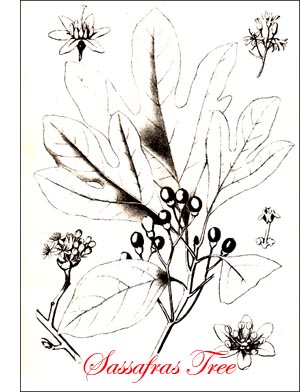Sassafras Tree
 Sassafras (Sassafras Sassafras, Karst.)-Tree, 30 to 50 feet high; rarely, in the South, 100 feet high with trunk 6 to 7 feet in diameter; top, flat or round, loose, open, irregular. Roots fleshy, aromatic, deep, throwing up suckers. Bark spicy aromatic, thick, dark brown, reddish, scaly and broken by shallow fissures into broad flat ridges; twigs, smooth, striated, green; mucilaginous.
Sassafras (Sassafras Sassafras, Karst.)-Tree, 30 to 50 feet high; rarely, in the South, 100 feet high with trunk 6 to 7 feet in diameter; top, flat or round, loose, open, irregular. Roots fleshy, aromatic, deep, throwing up suckers. Bark spicy aromatic, thick, dark brown, reddish, scaly and broken by shallow fissures into broad flat ridges; twigs, smooth, striated, green; mucilaginous. Wood dull brownish yellow, soft, weak, coarse, brittle, durable in the soil. Buds ovate, acute, greenish, aromatic. Leaves alternate, petiolate, sometimes opposite, q4 to 6 inches long, dull yellow-green, pale beneath, with entire margin; autumn colour orange; shapes vary: (a) ovate, (b) mitten shape, with one side lobe only, (c) 3 lobed, with a thumb on each side-the three shapes all on the same tree. Flowers in May, dioecious, pale yellow, in corymbose racemes on separate trees; staminate, with 9 stamens mounted in , rows on the 6-lobed calyx, minute glands, orange coloured, at base of inner whorl of 3 stamens; pistillate, with 6 abortive stamens in one row about single erect pistil.
Fruit soft, oblong, smooth, dark blue, on thickened scarlet calyx and pedicel. Preferred habitat, rich, sandy loam, borders of woodlands and peaty swamps. Distribution, southern Vermont west through Michigan and Iowa to Kansas. south to Florida and Texas. Uses: Wood makes posts and rails, boats and ox yokes. Bark of roots used as medicinal tea. Oil of bark used to flavour medicines. Valuable ornamental for its berries and brilliant autumn colouring. Attracts birds.
Who has not nibbled the dainty green buds of sassafras in winter, or dug at the roots for a bit of their aromatic bark? Or who has not searched among the leaves for "mittens"? Surely they are people whose youth was spent in regions that knew not this little tree of the fence corners and woodland borders. And they have missed something very much worth while out of their childhood.
Then there is the great green caterpillar with the Cyclopean black eye transfixing the culprit who dares disturb him on the soft silk mattress he has spun for himself on a sassafras leaf. When he is hung up like a mummy we have dared to carry him home, to learn that the "eye" is only a big black spot made to scare away birds, no doubt, which are looking for worms. Did you never see the glorious swallow-tail butterfly that comes out of that plump chrysalis in a day or two? Then you have, indeed, missed another joy, for no tiger of the jungle is more richly banded with black and yellow than this ranger of the meadows; in form and colouring and motions he is as beautiful as the flowers that supply him with nectar.
But there is the sassafras tree. When the butterfly is still in its tiny green eggshell, hidden by a provident mother in plain sight on the face of an opening leaf, the delicate greenish yellow flowers come out. The starry calyxes are alike on all the trees: But the stamens are all on one tree, nine in each flower, prominent, with bunchy glands at the bases of the inner ones. Plainly these flowers have pollen making for their duty. The pistillate flowers, with a row of abortive stamens at the base of the central style, grow in numbers on another tree. Here in autumn come the birds, even before the blue berries have softened on their coral pedestals. To leave them till they ripen would be to lose them to some other bird.
The glory of the autumn foliage of the sassafras is like the glory of a sunset-all mingled with purple and red and gold. The three forms of leaves that fascinated us in summer time are here yet, but the shining treetop is the unit now, and we do not look for individual leaves.
The wood of sassafras is light and tough, and makes good fishing rods. Durable in the -oil and in water, it is used for posts and rails, and for boats and barrels. The bark, especially of the roots, is strong in a volatile oil used to flavour medicines. The bark itself is sold in drug stores, and people buy it in spring and make sassafras tea "to clear the blood."
The leaves and twigs yield a mucilaginous substance which is used in the South to give flavour and consistency to gumbo soups. The useful properties of its various members are as nothing when compared with the beauty and desirability of the living tree, which is beautiful throughout the year-as a towering tree or a roadside sapling.
Sassafras Tree picture